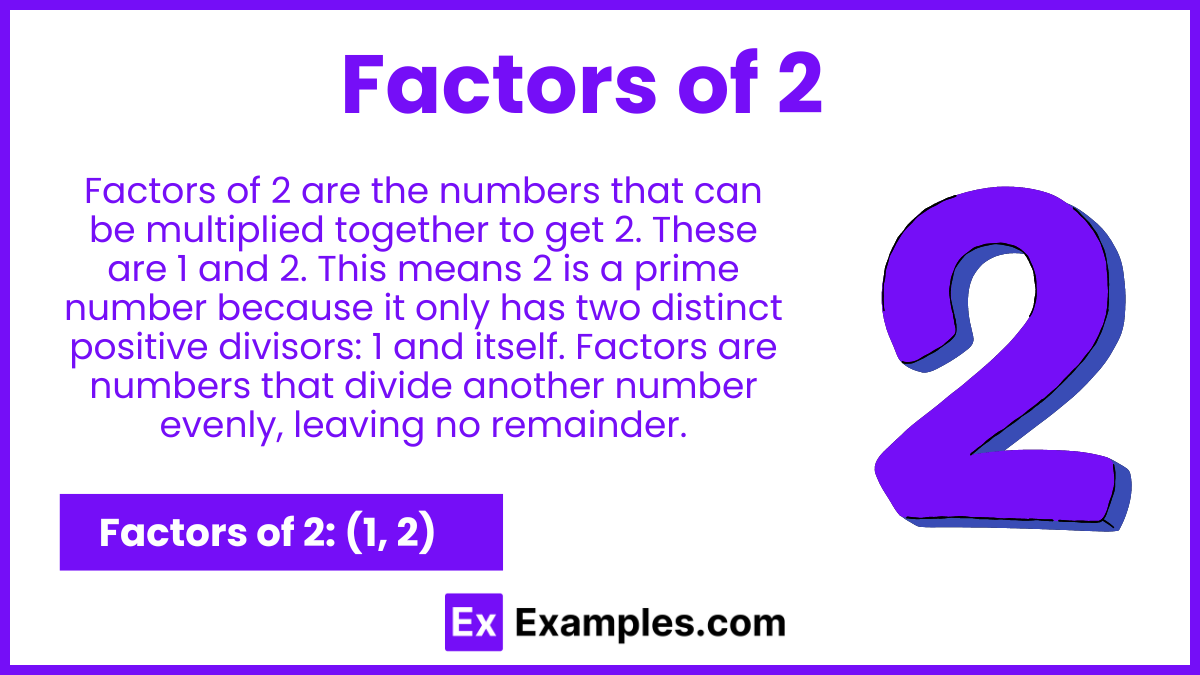What is the smallest factor of 2?
1
2
4
6

Factors are numbers that divide into another number exactly without leaving a remainder. When we talk about the factors of 2, we refer to all the numbers that can be multiplied together to result in 2. Understanding the factors of a number is fundamental in mathematics, especially in topics like multiplication, division, and prime factorization. In this article, we’ll explore the factors of 2, their significance, and their applications in various mathematical contexts.

The factors of 2 are 1 and 2. Factors are numbers that divide into another number exactly without leaving a remainder. Since 2 is a prime number, it has only two distinct factors: 1 and itself. This means that the only numbers that can be multiplied together to yield 2 are 1 and 2. In mathematical terms, this is expressed as 1×2=2. Understanding the factors of 2 is straightforward but essential, as it helps in grasping the basics of prime numbers and their properties, which are fundamental concepts in arithmetic and number theory.
Prime factors are the prime numbers that multiply together to give the original number.
A prime number has only two distinct positive divisors: 1 and itself. Since 2 can only be divided evenly by 1 and 2, it is a prime number.
Since 2 is a prime number, its only prime factor is itself. Therefore, the prime factor of 2 is 2.
Express 2 as a product of its prime factors. Since the only prime factor of 2 is 2, the prime factorization of 2 is: 2
This completes the calculation of the prime factors of 2.
Yes, 2 is a prime number because it has only two factors: 1 and itself. It is the smallest and only even prime number.
2 is considered important because it is the basis of binary code, which is essential in computer science and digital systems. Additionally, 2 is the only even prime number and plays a key role in various mathematical concepts and operations.
The prime factorization of 2 is simply 2, as 2 is a prime number and cannot be divided into other prime factors.
To determine if a number is a factor of 2, check if 2 can be divided by that number without leaving a remainder. Only 1 and 2 meet this criterion.
Factors of 2 are numbers that can divide 2 evenly, while multiples of 2 are numbers that can be divided evenly by 2. For example, 2, 4, 6, and 8 are multiples of 2.
Factors can be represented visually using factor trees or arrays. For example, the number 2 can be shown as a simple factor tree with branches splitting from 2 to 1 and 2.
Yes, the factors of 2 are also the divisors of 2. They are the same numbers: 1 and 2.
No, prime numbers have exactly two distinct factors: 1 and the number itself. Therefore, 2 cannot have any other factors.
Text prompt
Add Tone
10 Examples of Public speaking
20 Examples of Gas lighting
What is the smallest factor of 2?
1
2
4
6
Which of the following is a factor of 2?
1
2
3
4
How many factors does the number 2 have?
1
2
3
4
Which number is not a factor of 2?
1
2
3
4
What is the product of all factors of 2?
2
4
1
0
Which of the following numbers is a multiple of the factors of 2?
6
7
8
9
Which of the following numbers is a factor of 2?
1
3
5
7
If you multiply all factors of 2 together, what is the result?
1
2
4
6
Which number is a factor of 2 and also a factor of 8?
2
3
4
5
Which number is a factor of 2 and a multiple of 2?
2
4
6
8
Before you leave, take our quick quiz to enhance your learning!

